Kinnaur district
| Kinnaur district किन्नौर | |
|---|---|
| District of Himachal Pradesh | |
 Location of Kinnaur district in Himachal Pradesh | |
| Country | India |
| State | Himachal Pradesh |
| Headquarters | Reckong Peo |
| Area | |
| • Total | 6,401 km2 (2,471 sq mi) |
| Population (2011) | |
| • Total |
84,298 Male Population 46,364 or 42,173(2,001) Female Population 37,934 or 36,161(2,001). |
| • Urban | 0.00% |
| Demographics | |
| • Literacy | Average literacy rate of Kinnaur in 2011 were 80.77 compared to 75.20 of 2001. If things are looked out at gender wise, male and female literacy were 88.37 and 71.34 respectively. For 2001 census, same figures stood at 84.30 and 64.40 in Kinnaur District. Total literate in Kinnaur District were 61,639 of which male and female were 37,356 and 24,283 respectively. In 2001, Kinnaur District had 51,913 in its district. |
| • Sex ratio | With regards to Sex Ratio in Kinnaur, it stood at 818 per 1000 male compared to 2001 census figure of 857. The average national sex ratio in India is 940 as per latest reports of Census 2011 Directorate. In 2011 census, child sex ratio is 953 girls per 1000 boys compared to figure of 979 girls per 1000 boys of 2001 census data. |
| Website | Official website |
Kinnaur is one of twelve administrative districts in the Indian state of Himachal Pradesh, India. The district is divided into three administrative areas – Pooh, Kalpa, and Nichar – and has five tehsils (counties). The administrative headquarters of Kinnaur district is at Reckong Peo. From here Kinnaur Kailash, considered to be the abode of Lord Shiva, can be viewed. As of 2011 it is the second least populous district of Himachal Pradesh (out of 12 district), after Lahaul and Spiti,[1] but there are nine vital languages are spoken in the district.[2]
General
Kinnaur, is about 235 km (146 mi) from the state capital, Shimla, located in the northeast corner of Himachal Pradesh bordering Tibet to the east. It has three high mountains ranges, namely, Zanskar, Himalayas and Dhauldhar that enclose valleys of Sutlej, Spiti, Baspa and their tributaries. The slopes are covered with thick wood, orchards, fields and picturesque hamlets. At the peak of Kinnaur Kailash mountain is a famous natural rock Shivling (Shiva lingam). The district was opened to outsiders in 1889. The old Hindustan-Tibet Road passes through the Kinnaur valley along the bank of river Sutlej and finally enters Tibet at Shipki La pass.
It is not only the scenic beauty which appeals to the young and old alike but also the life styles of the people, their culture, heritage, customs and traditions. The people have strong culture and beliefs, generally follow Buddhism and Hinduism, believing the Pandavas came and resided in the land while in the exile<kamru village>. Thousands-year-old monasteries still exist in the area. Buddhists and Hindus live in harmony symbolising the traditional brotherhood and friendship of the people of both the faiths. Apples, chilgoza (chestnut) and other dry fruits are grown here. The high terrain here facilitates adventures and sports. Trekking routes include the 'Parikarma of Kinnaur Kailash'.
Geography
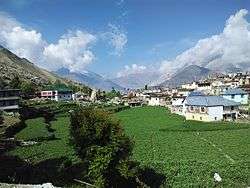
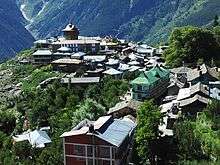

A mountainous area, ranging in altitude from 2,320 to 6,816 metres (7,612 to 22,362 ft), Kinnaur is one of the smallest districts in India by population. It is famous for the Kinnaur Kailash, a mountain sacred to Hindus, close to the Tibetan border.
Climate
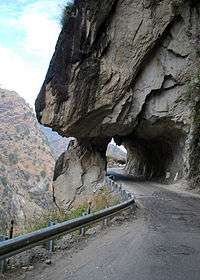

Most of Kinnaur enjoys a temperate climate due to its high elevation, with long winters from October to May, and short summers from June to September. The lower parts of the Sutlej Valley and the Baspa Valley receive monsoon rains. The upper areas of the valleys fall mainly in the rain-shadow area. These areas are considered to be arid regions, similar to the climate of Tibet. Central Asian landscape are common.
The people
The present day Kinnauras do not constitute a homogeneous group and display significant territorial and ethnic diversity. For a better understanding of ethnic and cultural distribution, Kinnaur district may be classified into three territorial units.
Lower Kinnaur comprise area between Chora at the boundary of the Kinnaur district with Rampur Bushahr and Kalpa including Nichar and Sangla valleys. The people of Lower Kinnaur are primarily of the Mediterranean physical type. It is difficult to distinguish them from the people residing in the adjoining Shimla district with whom they have some affinity. The people of lower Kinnaur are mostly Hindus though the ethno-historical factors have resulted in growing Buddhist influence.
The middle Kinnaur is the area between Kalpa and Kanam including Moorang tehsil. The people of middle Kinnaur are of mixed racial strain. Some have marked Mongoloid and others marked Mediterranean features. In some cases there is an admixture of the above two in varying degrees. The inhabitants are Buddhist as well as Hindus. Many people have faith in both the religions. It is very common to see Buddhist flag in most houses.
The upper Kinnaur comprises remaining north-eastern part of the district i.e. the area between Pooh (town) and Hangrang valley extending up to international border with Tibet. The predominant physical type of upper Kinnaur is the Mongoloid though a few persons with Mediterranean features are also seen in the area around Poo. Some persons show the blending of Mediterrean and Mongoloid elements in varying degrees. However the people of Hangrang valley are almost universally Mongoloids. They mostly follow Mahayana Buddhist religion.
The Kannaurs are very fond of music, dance and singing.
The Kinnaur society is divided into two broad occupational groups- peasants and the artisans possibly of diverse ethnic origin. These groups are represented by Gujjars and Kanet Rajputs and Scheduled Castes. The Kanets comprise the main cultivating community of the area and use honorific surname Negi. Among the Kanets there are three grades. In the first grade Kanets there are as many as fifty sub-castes, in the second grades there are seventeen sub-castes and in the third grade who work as potter have three sub-castes. Waza Kanets belong to the third grade and are considered inferior among Kanets. There are two Scheduled caste groups based on the occupation. One group traditionally make and wove clothes whereas the others are primarily blacksmiths. There is a third caste called who are carpenters. The main profession of Ores is carpentry. In social status the Ores are equal to blacksmiths. Among the scheduled castes blacksmiths and carpenters considered themselves superior to Weavers.
Languages
Kinnauri is often used as a generic term for all languages in the region. In the native language, Kinnauri is called,'kannauring-skad' which loosely translated to 'language of Kannauras.' Hindi is extensively used in the region as lingua franca among people from different regions of Kinnaur. The area used to be an extremely inaccessible and inhospitable in the past which didn't allow language contact and the languages developed in a rich environment without any external threats to their language or culture. Among earlierst to write about the language of Kinnaur Grahame Bailey, Alexander Gerald are Grierson- all British travellers who described the language in their notes and labeled them 'kannauri.'
Languages in Kinnaur
The main language is known as, 'Kinnauri or kannauri' in the academic world. It is a Tibeto Burman language with sporadic studies so far available. The natives though use this term to cover all the languages in the region. They just prefix before -skad, the name of the region where the language is spoken. Below is the language variety and its spread:
| Sl. No. | Language name | Villages | ISO 639-3 | Population | Social/Regional |
|---|---|---|---|---|---|
| 1 | Jangshung | Morang Tahsil, Jangi, Lippa, and Asrang villages | jna | 1,990 | Regional |
| 2 | Kinnauri | Chauhra to Sangla and north along Satluj river to Morang, upper Ropa river valley villages | kfk | 65,100 | Social |
| 3 | Kinnauri, Bhoti | Morang tahsil, upper Kinnauri Sutlej river basin where it becomes Spiti river, Morang tahsil, Nesang village, Pooh tahsil, Puh village. Possibly in Kuno, Charang villages | nes | 6,790 | Regional |
| 4 | Kinnauri, Chitkuli | Nichar subdivision, Sangla valley, Baspa river area, Chitkul and Rakchham villages | cik | 1,060 | Regional |
| 5 | Kinnauri, Lohari | Throughout Kinnaur district | -- | -- | Social |
| 6 | Kinnauri Pahari | Throughout Kinnaur district | kjo | 6,330 | Social |
| 7 | Shumcho | Pooh tahsil, Kanam, Labrang, Spilo, Shyaso, Taling, and Rushkaling villages | scu | 2,170 | Regional |
| 8 | Sunam | Pooh tahsil, Sunam village | ssk | 560 | Regional |
| 9 | Tukpa | Nesang, Charang, and Kunnu villages | tpq | 610 | Regional |
Artisans speak a different language, in kalpa tehsil, that falls in Indo Aryan family of languages. Bhoti language. The impact of Bhoti is less on Rakshmi and Chitkuli languages in comparison to languages spoken in upper regions of the district.
Food habits
The staple food is wheat, ogla, phafra and barley which are local produce. Besides these kankani, cheena, maize, chollair and bathu are also used. The principal pulses consumed are peas, black peas, mash and rajmash. The vegetables usually consumed are cabbage, turnips, peas, beans, pumpkin, potato, okra and tomato besides some locally available wild green vegetables leaves. They relish rice too which is imported from the plains. Drinking a salted tea called cha in the morning and evening is very popular among the Kannauras, usually drunk along with sattu made of parched barley flour. They are non-vegetarian and relish goat and ram's meat. Drinking of alcoholic beverages in both their day-to-day life and on the ceremonial or festive occasions is quite common. Alcohol is distilled at the household level, made out barley and of fruits like grapes, apple, pear etc. grown locally.
Religion
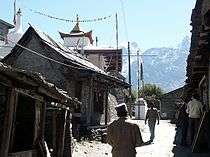
Religion is mixed and largely undocumented. In earliest times they appear to be animist and worshipped nature. But then they also have Hindu deities- Durga (Chandi), Bhairon, Usha (Ukha), Narayan, Vishnu, Badrinath and Bhimakali. The Blacksmiths and Carpenters have their favorite deities such as Nag Devta. Each village has their worn deity.
To describe the religion of people here, it is not Hinduism in its true mainstream form. It is animist with some influence from Hinduism. Lower region appear close to Hindu practices. As we move upwards in the region, Buddhism is also found along with traces of modern-day Hinduism. The important Hindu deities of middle Kinnaur include Chandi, Gauri Shankar, Kansa and Narayanjee. Dabla, the local god of Kanam village, has certain features traditionally associated with the Bon religion. The image of Dabla is installed along with those of Buddha and Guru Rinpoche (Padmasambhava) in one of the monasteries at Kanam.
The religion of upper Kinnaur is mostly Buddhist. Almost every village has a monastery with monks recruited from amongst the (Kanet).
Buddhism is the main religions in the district followed by Tibetan Buddhism, Bon is not practiced but some are mistakenly or bought by money. These three religions have undergone religious mixing, along with some indigenous shamanistic practices. One can see some Buddhist influences on the Hindu religion in Lower Kinnaur, the mixing of Buddhist and Hindu beliefs in varying degrees in Middle Kinnaur, and even the influence of Hinduism on Buddhism in Pooh of Upper Kinnaur. However, Buddhist Hangrang remains largely untouched by Hindu influence.
One can see Hindu gods being worshipped side by side with Buddhist deities in Buddhist and Hindu temples, especially in Middle Kinnaur. Dabla, one of the major Bön deities, is greatly revered by the Kinners in the area. Folk Hindu gods are also worshipped in Middle and Lower Kinnaur. These include the Durga (locally known as Chandi, Narayan, Vishnu) and many other folk Hindu–animist gods. Folk deities play a major role in the daily life of the Kinners.
Superstitions concerning animist ghosts such as Banchir, Rakshasas, and Khunkch also play an important role in the belief system of the Kinnouri. Pujas and horns of domestic animals are used to ward off the evil spirits, in order to bring good luck.
Buddhist lamas play an important role in the daily life of the Kinners, and young monks of Upper and Middle Kinnaur are trained from a young age in conducting religious ceremonies, devoting their lives to Lamaism and learning to read Tibetan scriptures and Buddhist doctrines. When they become Lamas (male monks) and Chomos (female nuns), they are given religious duties, which include presiding over the religious and secular affairs of the Kinners. They are generally divided into two groups, namely, the celibate Gyolang, who shave their heads, and the non-celibate Durpu, who do not shave their heads.
The Kinnaur Kailash is the most sacred mountain for most Kinners. Every year it is visited by thousands of locals on religious pilgrimages known as Yatra, Hindu and Buddhist alike.
Flora and fauna
Portions of Kinnaur are situated high in the Himalaya, where vegetation is sparse and consists primarily of hardy grasses. Alpine species such as juniper, pine, fir, cypress, and rhododendron can be found at elevations between 3,500 and 5,000 metres, primarily in Middle Kinnaur. At lower altitudes, temperate-climate trees are found, including oak, chestnut, maple, birch, alder, magnolia, apple, and apricot.
Yaks and dzos are reared by local farmers in the higher areas. Scattered populations of the Himalayan black bear and small ponies may also be found.
People
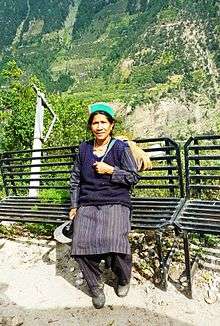
There are as many theories about the people of kinnaur. A Dardic influence is probably there, phenotypically. Looking at the present situation, people are of mixed ethnicity- lower kinnauras appear IA and upper kinnauras appear TB. The distinction was very stark some years back but now due to acceptance of inter region marriages, it has balanced the composition now.
Lifestyle
Generally, Kinner houses have storerooms for keeping grain and dried fruits, and separate wooden grain-storage structures, called kathar. Pakpa, a piece of sheepskin or yakskin, is often placed on the khayarcha mat.
Traditionally Kinners use utensils made of brass and bronze. Modern influences have included the introduction of Chinese crockery, and utensils made of stainless steel and aluminium.
Clothes are mainly of wool. The thepang, a grey woollen cap, is worn with a white velvet band. The Tibetan chhuba, a long woollen coat which resembles an achkan, is worn as well, with a sleeveless woollen jacket. While men wear woollen churidhar pajamas, and tailored woollen shirts such as the chamn kurti, the women wrap themselves up in a dohru. The first wrap of the dohru is based on the back, with embroidered borders displayed throughout its length, which stretches to the heels. Darker shades of colours are preferred for the Dohru, although other beautifully coloured shawls may be worn, usually draped over the shoulders. A choli, another type of full sleeved blouse worn by women, may serve as a decorative lining as well.
The Kinners are classified mainly into two castes: lower and upper caste. Again both of these categories are divided into sub classes. The caste system is more prevalent in the Lower and Middle Kinnaur regions.
History
Little is known about the history of Kinnaur, except for the fact that it was once known as Kanaurra or Kinnaura. There are, however, legends and myths among the inhabitants.
It is known that the area was placed under the control of the Magadha kingdom, followed by the Mauryan Empire during the 6th century BCE, which was then inhabited mainly by the Kirata, Kamboja, Panasika, and Valhika. Kinnaur also came under the influence of the Guge kingdom of Tibet between the 9th and 12th centuries.
Kinnaur was later divided into seven parts, known as Sat Khund. Conflicts in the region eventually gave rise to the formation of many small chiefdoms, which fought amongst one another for power. These struggles also included the neighbouring Bhotes. Several forts from this time, including Labrang, Moorang, and Kamru, serve as evidence of the region's history of conflict, which lasted until Emperor Akbar conquered the area. Akbar's conquest resulted in the incorporation of the Kinnaur valley into the Mughal Empire.
After the collapse of the Mughal Empire, the Kinnaur valley, then known as Chini Tehsil, played an influential role. When its dominant rôle in the region lapsed, it was merged to form part of the then Mahasu district. By 1960, political, ethnic, and cultural considerations led to the area being reorganised, forming the present Kinnaur district. In 1975 an earthquake struck the region.
Culture of Kinnaur is Tribal and fraternal polyandry is still present. This practice of polyandry was introduced in old times to balance survival as cultivated land is less and family planning was unheard. But with change of time and impact of education, now it is found it traces.
Demographics
According to the 2011 census Kinnaur district has a population of 84,298,[3] roughly equal to the nation of Andorra.[4] This gives it a ranking of 620th in India (out of a total of 640).[3] The district has a population density of 13 inhabitants per square kilometre (34/sq mi) .[3] Its population growth rate over the decade 2001-2011 was 7.61%.[3] Kinnaur has a sex ratio of 818 females for every 1000 males,[3] and a literacy rate of 80.77%.[3]
References
- ↑ "District Census 2011". Registrar General of India.
- ↑ "Language Map". Kinnaura Masihi Lok Sahitya Manch. Retrieved 6 November 2013.
- 1 2 3 4 5 6 "District Census 2011". Census2011.co.in. 2011. Retrieved 2011-09-30.
- ↑ US Directorate of Intelligence. "Country Comparison:Population". Retrieved 2011-10-01.
198 Andorra 84,825 July 2011 est.
- ↑ Lewis M, Paul. "Editor". SIL. Retrieved 5 November 2013.
External links
| Wikimedia Commons has media related to Kinnaur district. |
- A Official Web site of kinnaur
- DISTRICT PROFILE
- CULTURAL & TOURISM HERITAGE OF THE DISTRICT
- A book on Kinnaur and its people
- Government's district website
- The Himalayas-Kinnaur Himalayas
- Photo Documentation of Lahul-Spiti and Kinnaur-November 2003
- 24 pages of Information by Hindubooks
- About the 'Nako Research and Preservation Project (NRPP)' of the Vienna University, Austria
- Account of Koonawur etc., by Alexander Gerard (1841)
- Rakcham - A village in Kinnaur
- Murmur of the Lonely Brook - a book by Debashis Dey based on Kinnaur and the practice of Polyandry
- Photo Gallery of Kinnaur and Spiti - Winter 2013
- A Official Web site of kinnaur
 |
Kullu district | Lahaul and Spiti district |  | |
| Shimla district | |
China | ||
| ||||
| | ||||
| Uttarkashi district, Uttarakhand |
Coordinates: 31°35′N 78°25′E / 31.583°N 78.417°E

